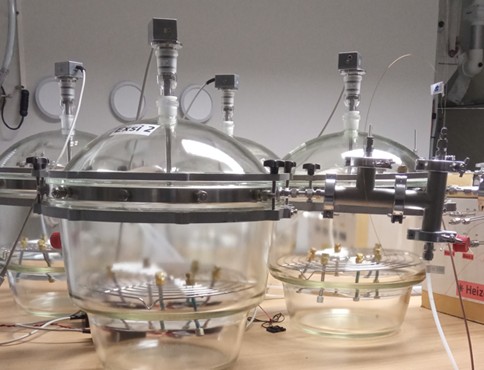
Exposure chambers in which passive samplers were exposed to a VOC/SVOC reference atmosphere for at least 7 days
Source: BAM
Construction products and other materials used indoors emit volatile organic compounds (VOCs) that can have harmful effects on the human organism. To assess the exposure of room users to these substances in the indoor air, passive samplers are used among other things. These are small tubes filled with an adsorbent into which the gaseous substances to be investigated diffuse and adsorb. They can be placed inconspicuously in the room. Aim of this study was to improve the traceability and comparability of indoor air measurements carried out with passive samplers – a key concern for health protection in homes, schools, and offices. Previous studies are mostly based on shorter sampling periods or theoretical models. Depending on the methodology used, the uptake rates differed significantly in some cases. To this end, passive sampler uptake rates for a total of 86 volatile and semi-volatile organic compounds (VOCs and SVOCs) were determined for a monitoring period of seven days, validated, and, where available, compared with literature values.
For this purpose, individual reference gas atmospheres were generated and the samplers exposed to them. The sensitivity of the values to variations in exposure time, temperature, and relative humidity was investigated with some representatives of the selected substance groups. Here, a decrease in the uptake rate with the exposure time could be observed stabilising from the fifth day of exposure onwards. This suggests that a minimum exposure time of seven days is reasonable and should not be significantly reduced if possible. No significant impact of temperature and humidity on the uptake rate was observed. The methodology proposed and validated here allows for a realistic determination of uptake rates for typical exposure times. The data enable a reliable assessment of indoor air quality, which is particularly important for vulnerable groups such as children and the elderly. The work provides robust reference data for passive indoor air monitoring and contributes to the standardisation of measurement methods—an important step toward comparable, reliable indoor air analysis.
Experimental determination of 7-day uptake rates for diffusive sampling of 86 volatile and semi-volatile organic compounds relevant for indoor air monitoring and investigation on their sensitivity to exposure time and indoor climate
Matthias Richter, Florian Schühle
Indoor Environments, Volume 2, Issue 2, 2025


